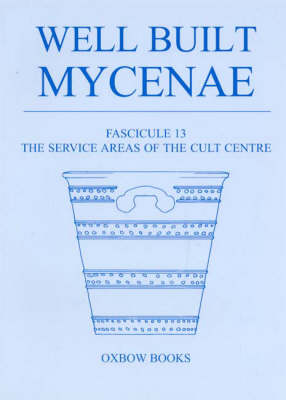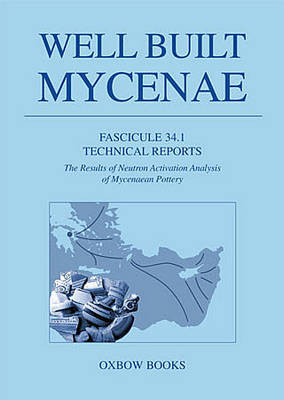Well Built Mycenae
1 primary work • 3 total works
Book 13
The 'Service Areas' of the Cult Centre comprise a number of rooms, open spaces and passages adjacent to the buildings which form the Temple Complex (WBM 10) and the Room with the Fresco Complex (WBM 11, forthcoming). Excavation of these areas has helped to determine their history and the changes that took place in their orientation and in access to them during the 13th C BC.
The finds made are of considerable interest, individually and as groups, and contribute to our understanding of the activities which took place in the areas around the principal Cult Centre buildings. The importance of Area 36, in particular, was apparent during excavation: among the finds, apart from extraordinary quantities of once whole pottery vessels, was a steatite block carved as a jewellery mould, a number of glass beads and bronze tools as well as mortars and other objects of stone. The stratigraphic position of this material confirmed that it was deposited at the same time as the ivories and other objects in the Room with the Fresco.
The printed text of c 50 pages provides an illustrated account of the excavation, the structures and the principal finds together with discussions of the significance of each. The accompanying CDs contain over 375 pages of data including Room and Materials analyses similar to those presented in Fascicule 10. The full catalogues of nearly 300 intact or restorable pottery vessels of a wide variety of shapes and uses are accompanied by photographs and line drawings of each item. These are a remarkable addition to our knowledge of Mycenaean pottery, whether for comparative studies of style and decoration or for questions of function.
The finds made are of considerable interest, individually and as groups, and contribute to our understanding of the activities which took place in the areas around the principal Cult Centre buildings. The importance of Area 36, in particular, was apparent during excavation: among the finds, apart from extraordinary quantities of once whole pottery vessels, was a steatite block carved as a jewellery mould, a number of glass beads and bronze tools as well as mortars and other objects of stone. The stratigraphic position of this material confirmed that it was deposited at the same time as the ivories and other objects in the Room with the Fresco.
The printed text of c 50 pages provides an illustrated account of the excavation, the structures and the principal finds together with discussions of the significance of each. The accompanying CDs contain over 375 pages of data including Room and Materials analyses similar to those presented in Fascicule 10. The full catalogues of nearly 300 intact or restorable pottery vessels of a wide variety of shapes and uses are accompanied by photographs and line drawings of each item. These are a remarkable addition to our knowledge of Mycenaean pottery, whether for comparative studies of style and decoration or for questions of function.
Book 34.1
Since 1890 when Sir Flinders Petrie first realised the importance of the Aegean pottery he had found in Egypt further discoveries of these wares have been noted with more than superficial interest. Early studies, however, right up to the mid 20th century, had to be based on stylistic, and thus often subjective, criteria. It is only more recently with the development of a range of scientific techniques that it has become possible to make serious attempts to ascertain the exact sources of this imported pottery. A key factor in this work has been the establishment of data banks by which to define the various possible sites of origin. Samples from Mycenae, as one of the key nodes of Late Bronze Age trade, were taken both as part of the initial programme of research by the Research Laboratory at Oxford and then in the wider projects carried out in the Laboratory of the University of California, Berkeley, by Professors Frank Asaro and Isadore Perlman and by the Department of Nuclear Chemistry of the University of Manchester. Though the results of these studies have been made public and widely used, the full details pertaining to the core area of the Argo-Corinthia have never been published. This fascicule of the Well Built Mycenae series presents for the first time the raw data as well as the statistical analyses based on it and assesses the impact of the various methods on the archaeological value of the research. Thus by giving an outline of the relation between these results and the on-going archaeological work at Mycenae and in the surrounding area we can see into which fields of study future work should be directed. Includes a DVD with accompanying material for 34.1 and all previous fascicules.
16/17
Well Built Mycenae, Fasc 16/17
by Gordon Hillman, E. B. French, and Susan Sherratt
Published 15 April 2011
The post-palatial period - Late Helladic IIIC - is often seen as the twilight years of Mycenean civilisation, a period of economic decline with few achievements in terms of architecture, materials or technology. Excavation in the Citadel House area at Mycenae afforded unique opportunities to explore stratified remains of this period and to define and describe its character. In this fascicule, Dr. Elizabeth French presents her full report on the remains of this period, which, sheltered within the massive 13th century BC walls, allow us to chart something of Mycenae's history in the final years of the Bronze Age. This fascicule also contains a unique account of LH IIIC pottery, stratum by stratum, incorporating a major study by Dr. Susan Sherratt, together with a wealth of illustration of pottery vessels. The account of the other objects of terracotta, metal, ivory, stone and bone helps us to better understand the cultural materials of the post-palatial period, while Gordon Hillman's account of the plant remains from the "Granary" is a significant addition to the palaeo-botanical record for the Mycenean period as a whole and one of very few for the LH IIIC period. This book, which includes a DVD containing all the data from previous fascicules and an interactive index, will be an essential reference tool for the study of the period.


